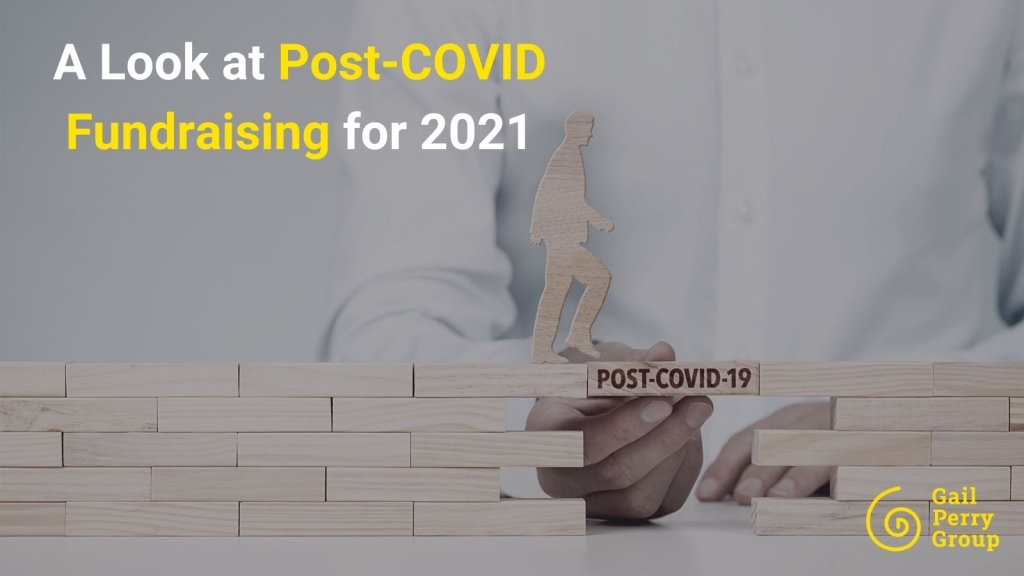
What is the outlook for post-COVID fundraising? There’s good news to share!
Giving is up – right now – across the board.
What’s more, the outlook for charitable giving in the next year or two is also looking very good. We predicted a number of positive trends for 2021, and are happy to see some come to fruition so soon.
Recent reports and studies are showing positive signs on the giving horizon.
First of all, here’s a look at recent trends from 2020.
Giving in 2020 was up significantly.
A report issued by the well-respected Fundraising Effectiveness Project (FEP) managed by the Association of Fundraising Professionals, showed that last year, overall charitable giving grew a whopping 10.6% in 2020 over 2019.
This is really cause for celebration.
The Fundraising Effectiveness Project’s Growth in Giving database charts giving trends from 2,496 organizations that raise $100k – $10 million annually. Clearly this increase in giving was driven by donors reaching out to help those in economic hardship during the pandemic. But many charities of all types saw giving increases.
Small donors are back!
Some of the best news is that small donors, who provide much of the sustainable annual giving for many nonprofits, are returning. We’ve been very worried that small donor gifts had been declining over the past few years. Moreover, these smaller donors are the backbone of many nonprofit organizations’ financing.
Here’s the FEP data as reported by the Chronicle of Philanthropy:
Gifts of less than $250 grew by a total of 15.3% last year over 2019.
$250-$999 gifts increased by 8%.
Gifts of $1,000 or more grew by 10.4%.
But there’s worrisome news too: Donor retention plunged again to a low of 43.6%. (the lowest donor renewal rate since the FEP began tracking in 2004-05.) This means that less than half of the donors who gave in 2019 repeated their support by giving again in 2020.
Donor loyalty continues to be one of the greatest challenges of many fundraising programs. Retention rates of new donors continue to decline.
Post-COVID fundraising outlook.
Looking ahead, there’s great news on the horizon. So, what can we expect from post-COVID fundraising?
Projections show an excellent outlook for fundraising in 2021 and 2022. The well-respected Lilly Family School of Philanthropy recently shared a report projecting total giving to rise 4.1% in 2021, and 5.7% in 2022.
When you look at individual giving, which supplies the majority of many organizations’ contributed revenue, the Lilly report forecasts a year-over-year rise of 6% in 2021.
This is great news for many nonprofits.
Why the rosy forecasts for 2021 and 2022?
For decades we have seen giving levels follow the U.S. stock market. When the stock market rises, charitable giving also goes up. We find that when donors’ portfolios are growing robustly, then donors feel more wealthy. When your major donors are feeling wealthy, then their charitable gifts often increase.
To quote the Lilly report:
“Individual and household giving is influenced by growth in the S&P 500, especially giving by those with median and higher levels of income. A large body of work demonstrates, with few exceptions, that as income and wealth increase, so do the amounts that households give to charity.”
Estate gifts are also projected to rise over the next couple of years.
This is, again, because of the robust stock market. It’s because the amount of an estate gift ultimately depends on the value of the estate’s assets. Many estates include substantial stock investments, which have appreciated nicely in the past few years. So any bequests your nonprofit is targeted to receive will be more highly valued than before.
The Lilly report bases its rosy outlook on several assumptions – namely that the economy will continue to stabilize and grow as people receive vaccinations and life begins to return to “normal.”
Ultra-high-net-worth gifts are also seeing an uptick right now, reports the Chronicle of Philanthropy. Billionaire William Ackman recently donated shares worth one billion, and other mega donors like Elon Musk recently made 9-figure gifts.
Bottom Line: Post-COVID fundraising outlook.
What does this robust forecast mean? It means take heart. Things are looking up. Keep a sense of optimism and possibility about your fundraising. You’ll likely see that your own donors are also primed to give.
As always, it is a pleasure to share our weekly news and insights with you.
If your organization is planning a capital campaign – we can help. We’re with our clients every step of the way, inspiring their teams and board, building confidence, driving action and measuring success. Send an email to coaching@gailperry.com if you’d like to schedule a strategy or consulting call with us.










